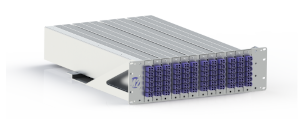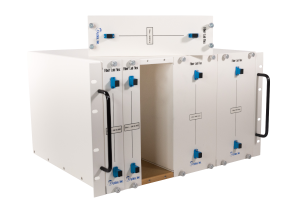Data Centers and AI – Simulating Fiber Link Latency & Performance is Crucial
In the rapidly growing and evolving digital cloud, the success of delivering AI technology solutions not only depends on algorithms and computational power, but also on the physical infrastructure that supports it. Optical fibers play a pivotal role as the backbone for information transmission, especially within data centers that are now hosting AI technology. For people designing, deploying, or certifying/validating AI data center network equipment, along with the data centers responsible for hosting and managing this equipment, precisely simulating optical fiber link characteristics and latency is essential for ensuring optimal performance.
Optical Fiber: The Backbone of AI Data Centers

Before discussing simulating optical fiber spans supporting AI technology, let’s quickly recap the reasons why optical fiber is the winning medium of choice for this purpose in the data center environment.
- Extensive Bandwidth Capacity and Data Transmission Speeds
Optical fiber offers unparalleled data transmission speeds, making it the preferred choice for AI data centers. These centers process vast amounts of data, necessitating a medium that can handle the high bandwidth requirements. - Low Latency
With its ability to transmit data at the speed of light, optical fiber significantly reduces latency between equipment and across the entire network. This increases the overall efficiency of data processing and analysis, while ultimately delivering information to the intended destinations as quickly as possible. - Reliability and Scalability
AI technologies require not only speed but also reliability and scalability. Offering low signal loss and other environmental stability benefits over alternative approaches like copper, optical fibers provide consistent performance, even in extensive data center environments and between data center sites. This reliability is crucial for AI applications where accuracy and timely data analysis are paramount. Additionally, optical fiber capacity can be efficiently scaled, both in terms of physical fiber counts along with supporting advanced transmission technologies like wavelength division multiplexing. - Supporting Heavy AI Workload Demands
AI workloads are not only voluminous but also complex. They involve real-time data analytics, machine learning, and other computational-heavy tasks. Optical fiber networks support these demands by providing a high-capacity, low-latency environment. This ensures that AI technologies can function at optimal levels, enabling faster decision-making and more sophisticated AI capabilities.
The Importance of Simulating Optical Link Characteristics and Latency for AI Technology

In the previous section, we discussed the benefits of optical fibers for data transmission in and between data centers hosting resource-heavy AI technology and gear. Specifically, its low-latency ability to deliver high volumes of data.
Due to the critical role the fiber infrastructure plays, many fiber-specific factors must be considered and validated by all interested parties—equipment manufacturers through integrators. Differences in fiber types, lengths (distances and delay values), and optical characteristics are just a few of these fiber factors that must be evaluated and accurately simulated to ensure the devices and overall network achieve the intended performance or goals.
The best practice is to use customized fiber network and latency simulators to accurately simulate the performance of fiber spans and links. These efficient rack-mount enclosure platforms, like the one shown below, are designed to include the actual lengths of fiber in a spooled or coiled format, replicating the desired span lengths along with optical and latency performance.

Fiber Lab Flex DC: 144 customized data center fiber spans in a 3RU enclosure
Now, we’ll examine a few of the application areas these solutions address and explain why simulating the fiber infrastructure of your AI technology in the data center is essential.
- Accurate Device Design and Network Deployment
For those involved in the design and deployment of devices and networks supporting AI, precisely simulating span performance and latency is critical. This step in the testing and validation process demonstrates how the devices and network will perform under various conditions or setup configurations, allowing for adjustments before market launch or full-scale deployment. Providing an opportunity to test using various fiber types, lengths, and connectivity configurations, fiber simulation ensures that both devices and the network are designed with the optimal architecture to support the specific needs of AI applications. In turn, this helps to minimize potential issues, bottlenecks, and latency, while maximizing overall system efficiency. - Stress Testing and Validation
Simulating a data center’s optical fiber infrastructure allows for comprehensive stress testing of the network. Accurately replicating the real-world span lengths and optical characteristics and then connecting it to the network gear allows engineering to evaluate how the network handles peak loads, data surges, and other stress scenarios. This testing is vital for validating that the network meets all performance, reliability, and scalability requirements, ensuring it will support the heavy demands of AI applications. - Certifying Network Equipment
Before engineering and technical teams can install network equipment in AI data centers, they must first evaluate and determine which equipment and devices will be best suited to their requirements. In other words, before deploying network equipment in AI data centers, gear must be tested and certified that it will achieve the intended compatibility performance standards. Using a customized network and latency simulator to precisely replicate the actual fiber optic spans and links within the data center allows for this equipment to be tested in a manner that mirrors the true and exact data center infrastructure. This process helps to identify any equipment performance or compatibility issues, drawbacks, or other unanticipated challenges, thus aiding in the process of selecting and installing the appropriate network gear for the live AI network.
While the importance of performing data center fiber network and latency simulation testing cannot be understated, the next question is often, “How do we do this effectively and efficiently?” Fortunately, a range of proven solutions for test labs and data centers exist that suit virtually any user-specified setup configuration requirements.
Fiber Lab: The Trusted Solution for Data Center AI Network and Latency Simulation
For those seeking the best practice approach for exactly replicating the fiber spans and links for data center AI applications, contact M2 Optics to learn more about Fiber Lab customized fiber network link and latency simulators.
Offering unprecedented levels of customization in the most efficient enclosure formats, every Fiber Lab is built to user specification, delivering maximum fiber ROI, space efficiency, and most importantly, consistent and accurate performance results.
Click Here to Learn More / Customize A Fiber Lab
 |
|





